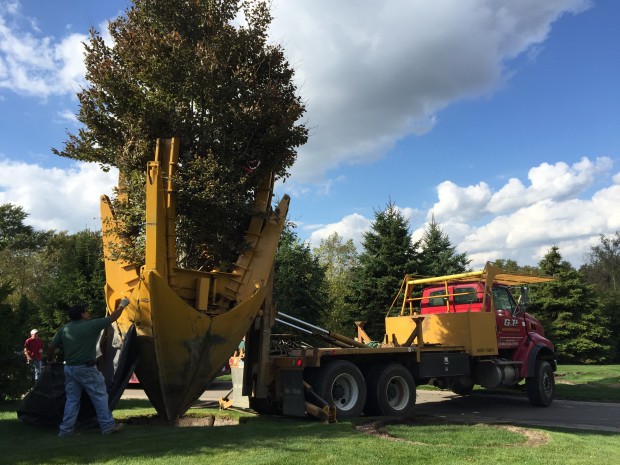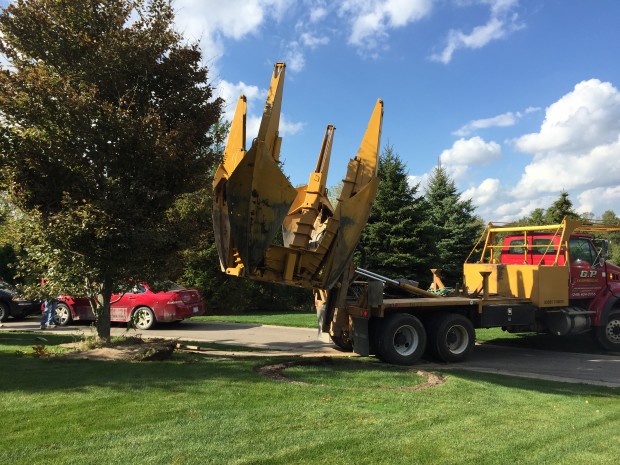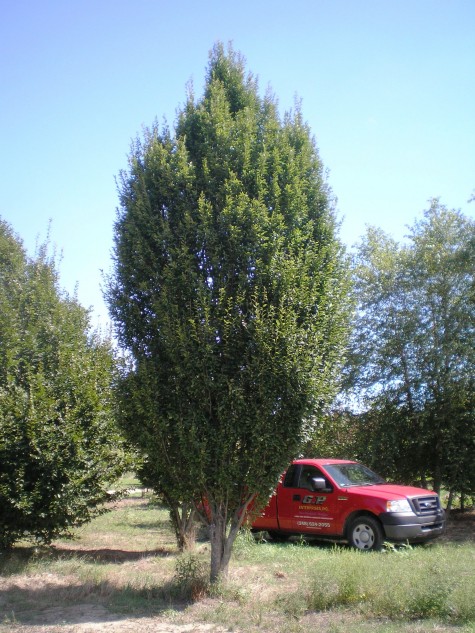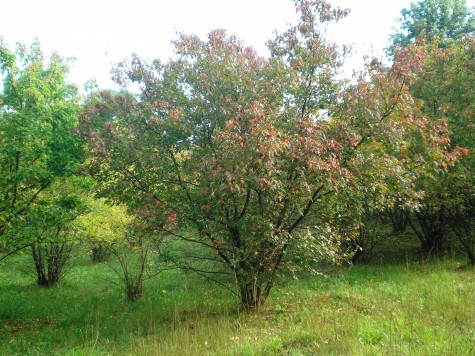 The very first tree I ever planted was a gingko. My Mom and I, with not much discussion or ceremony, planted 10 seeds in small plastic pots. As I was probably 7 years old, it never occurred to me to ask where she got the seed. As she was a fairly reserved parent, there was no presentation about how to successfully grow trees from seed, or why growing a tree from a seed was a worthwhile and satisfying use of one’s time. Or that trees in general are one of the great wonders of the natural world. I do remember that only one seed germinated. That pot was buried in the rose garden for several years, until that gingko was about 15″ tall. I watched her dig up a patch of grass in the side yard. In the process of getting the gingko out of the pot, I knocked all the soil off of the roots. I was horrified-I thought I had killed it. She just scooped up that bareroot tree, and planted it in one fell swoop-the entire planting took but seconds. I would be in charge of the water to that tree for years to come. Once I turned 13, I had to be sent to the tree to water. Once I turned 16, my attitude shifted. There was a lot of satisfaction to watching that tree grow-and grow it did. By the time I went to college, it was a proper tree, a young but substantial element of our suburban landscape.
The very first tree I ever planted was a gingko. My Mom and I, with not much discussion or ceremony, planted 10 seeds in small plastic pots. As I was probably 7 years old, it never occurred to me to ask where she got the seed. As she was a fairly reserved parent, there was no presentation about how to successfully grow trees from seed, or why growing a tree from a seed was a worthwhile and satisfying use of one’s time. Or that trees in general are one of the great wonders of the natural world. I do remember that only one seed germinated. That pot was buried in the rose garden for several years, until that gingko was about 15″ tall. I watched her dig up a patch of grass in the side yard. In the process of getting the gingko out of the pot, I knocked all the soil off of the roots. I was horrified-I thought I had killed it. She just scooped up that bareroot tree, and planted it in one fell swoop-the entire planting took but seconds. I would be in charge of the water to that tree for years to come. Once I turned 13, I had to be sent to the tree to water. Once I turned 16, my attitude shifted. There was a lot of satisfaction to watching that tree grow-and grow it did. By the time I went to college, it was a proper tree, a young but substantial element of our suburban landscape.
 My Mom moved while I was in college, closer to the school where she taught. I would eventually move near her. That gingko tree was on its own, on the other side of town. If I ever had cause to drive from the west to the east side, I would go to see the tree. It would always be there, just a little bit larger than the last trip. Gingkos are slow growers. Several weeks after she died, I went to see the tree. It was a comfort to me, that 45 year old tree, living and growing. It was such a beautiful tree, all on its own, set in the lawn. 10 years after she died, I went to see the tree, but it was gone. There was no sign it had ever been there. The shock and the grief was unsettling. Every gardener has a hefty respect and affection for trees.
My Mom moved while I was in college, closer to the school where she taught. I would eventually move near her. That gingko tree was on its own, on the other side of town. If I ever had cause to drive from the west to the east side, I would go to see the tree. It would always be there, just a little bit larger than the last trip. Gingkos are slow growers. Several weeks after she died, I went to see the tree. It was a comfort to me, that 45 year old tree, living and growing. It was such a beautiful tree, all on its own, set in the lawn. 10 years after she died, I went to see the tree, but it was gone. There was no sign it had ever been there. The shock and the grief was unsettling. Every gardener has a hefty respect and affection for trees.
 My second tree planting was in my twenties. I was visiting a friend in Kalamazoo. We were both gardeners, so a good part of every visit was consumed visiting nurseries. One nursery had a tall adolescent tulip tree in an undersized pot, with one green and orange “tulip” blooming at the top. I had to have that tree. The leaf shape was so beautiful! I drove that tree home in my pickup truck, and hauled it all over my property until I decided where to plant it. I chose a place where it would be free to grow as big as it could. I was unaware that liriodendron are tap rooted, and very difficult to transplant. I stripped the sod from the spot, dug down deep, and amended the heavy clay soil, and put that tree in the ground. I kept it watered without any coaching. Miraculously, it took hold. There were never any more tulips as long as I lived there. When I moved 15 years later, it was just beginning to put on weight. I know better now than to go back. I prefer to believe it is still there, growing taller and bigger every year.
My second tree planting was in my twenties. I was visiting a friend in Kalamazoo. We were both gardeners, so a good part of every visit was consumed visiting nurseries. One nursery had a tall adolescent tulip tree in an undersized pot, with one green and orange “tulip” blooming at the top. I had to have that tree. The leaf shape was so beautiful! I drove that tree home in my pickup truck, and hauled it all over my property until I decided where to plant it. I chose a place where it would be free to grow as big as it could. I was unaware that liriodendron are tap rooted, and very difficult to transplant. I stripped the sod from the spot, dug down deep, and amended the heavy clay soil, and put that tree in the ground. I kept it watered without any coaching. Miraculously, it took hold. There were never any more tulips as long as I lived there. When I moved 15 years later, it was just beginning to put on weight. I know better now than to go back. I prefer to believe it is still there, growing taller and bigger every year.
 I was working for Al Goldner, at Goldner Walsh Nursery, when I had occasion to plant my third tree. He had a dawn redwood that had lost its leader. It was header for the compost pile. When I asked him if I could take it home, he only said that the tree would never be right without its leader. Plant it I did, in a swampy spot where it grew every bit of 18 inches a year. Its shape was definitely asymmetrical, but it had a strange and atypical beauty that enchanted me. My fourth tree was a London Plane that had not been sold, but needed to go in the ground. Al gave that tree to me as well. It was so large that it took me days to dig the hole. I needed every friend I had to help me roll it in the hole. It took years before that tree took hold, and started to grow. My property was almost 5 acres. I had plenty of room for trees. I was beginning to understand a few things about planting them.
I was working for Al Goldner, at Goldner Walsh Nursery, when I had occasion to plant my third tree. He had a dawn redwood that had lost its leader. It was header for the compost pile. When I asked him if I could take it home, he only said that the tree would never be right without its leader. Plant it I did, in a swampy spot where it grew every bit of 18 inches a year. Its shape was definitely asymmetrical, but it had a strange and atypical beauty that enchanted me. My fourth tree was a London Plane that had not been sold, but needed to go in the ground. Al gave that tree to me as well. It was so large that it took me days to dig the hole. I needed every friend I had to help me roll it in the hole. It took years before that tree took hold, and started to grow. My property was almost 5 acres. I had plenty of room for trees. I was beginning to understand a few things about planting them.
 Over the course of my career, I have planted a lot of trees. Under story, or smaller growing trees are easy to place in just about any landscape. Their mature size is friendly and companionable with perennial gardens and shrubs, and smaller urban properties. The variety of species and cultivars available at nurseries is extensive. A gardener would need a very large property to grow one of every tree available in commerce. Trees are grown and sold in a variety of sizes. The modest cost of a small tree in a pot makes it possible to plant a grove. My company rarely handles a tree with a root ball over 40 inches in diameter. A root ball this size will weigh almost 1000 pounds. Some nurseries grow very large specimen trees. Luckily there exists sophisticated technology, and expert large tree movers such as GP Enterprises, that permits moving and replanting very large trees.
Over the course of my career, I have planted a lot of trees. Under story, or smaller growing trees are easy to place in just about any landscape. Their mature size is friendly and companionable with perennial gardens and shrubs, and smaller urban properties. The variety of species and cultivars available at nurseries is extensive. A gardener would need a very large property to grow one of every tree available in commerce. Trees are grown and sold in a variety of sizes. The modest cost of a small tree in a pot makes it possible to plant a grove. My company rarely handles a tree with a root ball over 40 inches in diameter. A root ball this size will weigh almost 1000 pounds. Some nurseries grow very large specimen trees. Luckily there exists sophisticated technology, and expert large tree movers such as GP Enterprises, that permits moving and replanting very large trees.
 A tree spade is a flat bed truck, outfitted with a hydraulically powered set of four blades that can remove a cone shaped mass of soil 10′ in diameter, and better than 6 feet deep. The spade can likewise dig a large tree, and transport it horizontally on the truck bed to a replanting location. A 5 inch caliper tree – the caliper being the diameter of the trunk 6 feet from the ground – will require a 5 foot diameter root ball to insure a successful transplant. A 5′ diameter root ball weighs about 2800 pounds. We are in the process of installing a landscape on a very large property. Big trees will help to provide a sense of scale and age to the landscape. This tricolor beech is 35 years old. It is possible to move a tree of the age, as it has been root pruned, dug and moved a number of times at the nursery. Moving a tree from the wild would of the age would be much more difficult.
A tree spade is a flat bed truck, outfitted with a hydraulically powered set of four blades that can remove a cone shaped mass of soil 10′ in diameter, and better than 6 feet deep. The spade can likewise dig a large tree, and transport it horizontally on the truck bed to a replanting location. A 5 inch caliper tree – the caliper being the diameter of the trunk 6 feet from the ground – will require a 5 foot diameter root ball to insure a successful transplant. A 5′ diameter root ball weighs about 2800 pounds. We are in the process of installing a landscape on a very large property. Big trees will help to provide a sense of scale and age to the landscape. This tricolor beech is 35 years old. It is possible to move a tree of the age, as it has been root pruned, dug and moved a number of times at the nursery. Moving a tree from the wild would of the age would be much more difficult.
 No matter the size, moving a tree is never easy. Every balled and burlapped tree has had many roots critical to its health and well being cut off in the process of making it movable. A large canopy tree with an abruptly reduced root system will suffer transplant shock, until enough roots grow back to adequately support the life of that canopy. It will take a year for every inch of caliper for that tree to recover sufficiently to begin growing again. A one inch caliper tree will resume growing after one season in the ground. A ten inch caliper tree will take 10 years to become completely established.
No matter the size, moving a tree is never easy. Every balled and burlapped tree has had many roots critical to its health and well being cut off in the process of making it movable. A large canopy tree with an abruptly reduced root system will suffer transplant shock, until enough roots grow back to adequately support the life of that canopy. It will take a year for every inch of caliper for that tree to recover sufficiently to begin growing again. A one inch caliper tree will resume growing after one season in the ground. A ten inch caliper tree will take 10 years to become completely established.
 This tricolor beech has a very good new home. It was transplanted with a good deal of care. It is planted in a space where it has plenty of room to grow. Best of all, there is a committed client who will not only truly enjoy it, they will look after it as it should be.
This tricolor beech has a very good new home. It was transplanted with a good deal of care. It is planted in a space where it has plenty of room to grow. Best of all, there is a committed client who will not only truly enjoy it, they will look after it as it should be.






